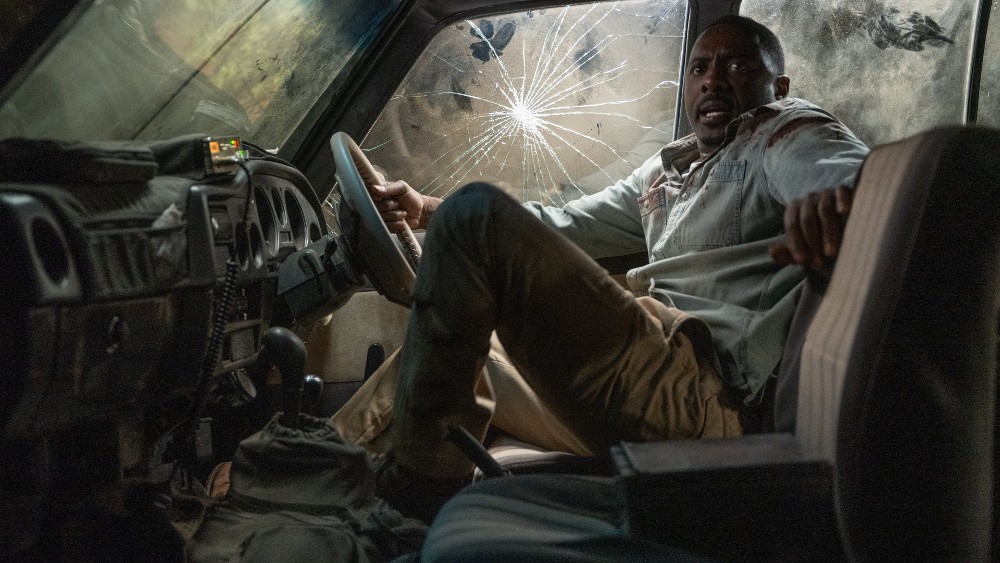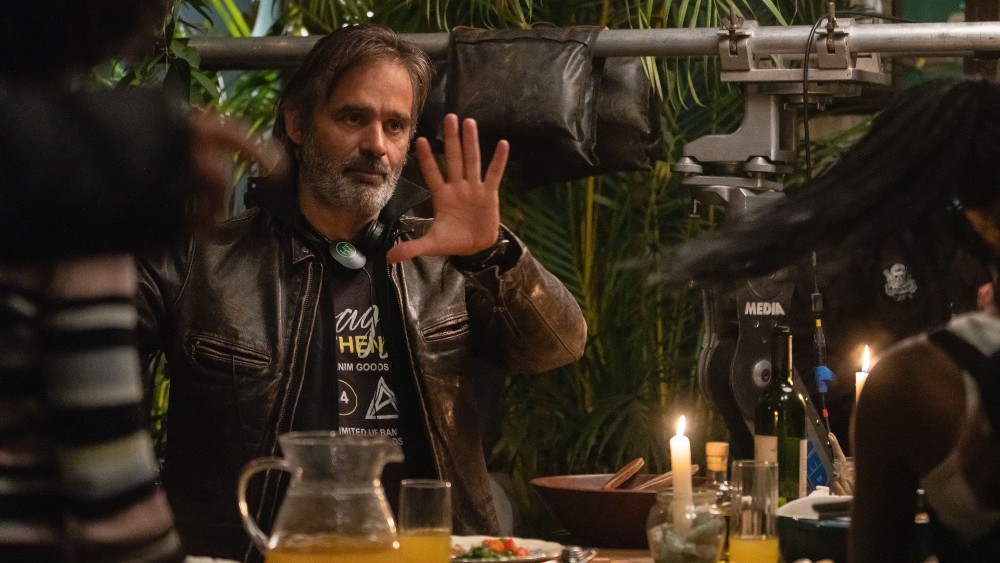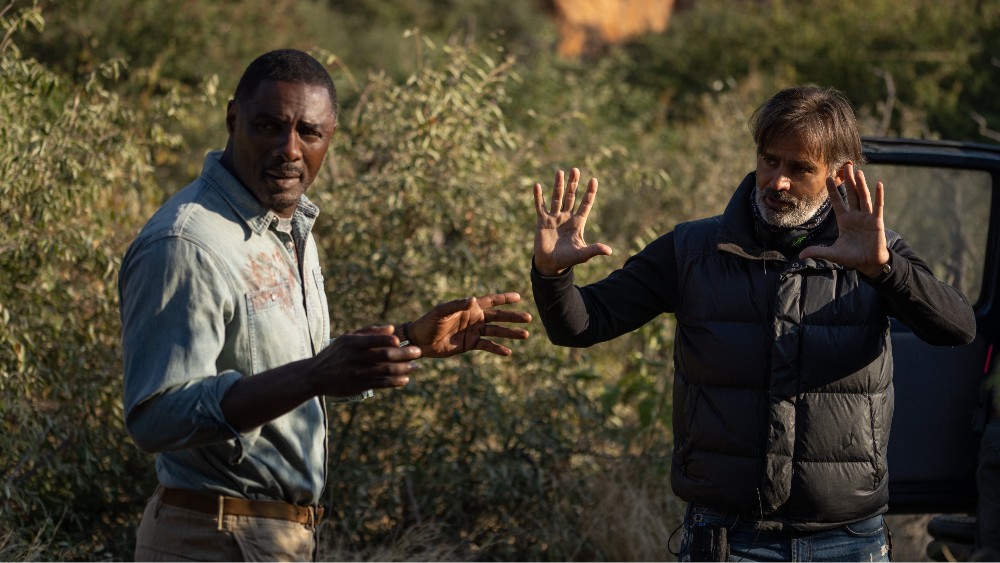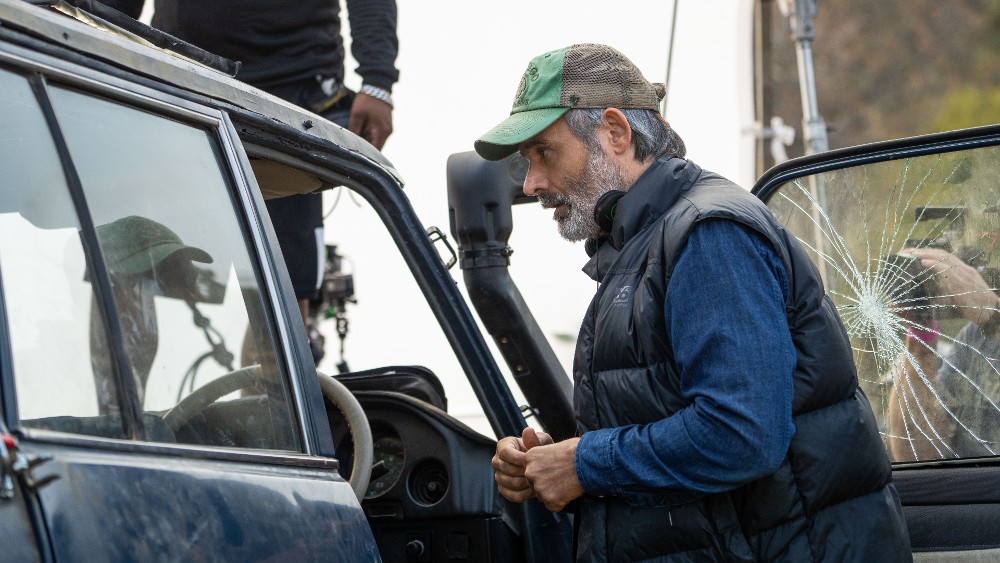
Director Baltasar Kormákur has been bouncing between making studio movies and films in his native Iceland for over 20 years, first breaking onto the scene with 101 Reykjavik back in 2000. Even once Hollywood came calling, Kormákur’s heart never strayed far from Iceland’s film business, and his early English-language film Contraband was actually a remake of the Icelandic film Reykjavik-Rotterdam, which he had produced.
Kormákur’s latest film is Beast, a tense thriller that stars Idris Elba as Dr. Nate Samuels, a widower who brings his two teenage daughters (Iyana Halley and Leah Sava Jeffries) to Africa in order to see their late mother’s original home. Once there, they connect with a family friend, biologist Martin Battles (Sharlto Copley), who maintains a reserve there and takes them on an expedition to see the land, during which they encounter a rogue lion that kills anyone who dares to enter its territory.
It’s a fantastic thriller that brilliantly combines practical locations with visual effects, and it really is a great showcase not only for Kormákur but also for his below-the-line collaborators. Below the Line spoke to Kormákur about those things over Zoom for the following interview:
Below the Line: How did this come together with you directing and Will Packer producing?
Baltasar Kormákur: I think it was just through [Universal President of Production] Peter Kramer, [who] suggested [that we] work together, so they brought me this project during COVID when I was fighting COVID back home, trying to keep production going. They sent me this, and the idea of shooting a lion in Africa sounded really good to me, and then Idris Elba was also a great addition to that. This came easily and quickly, and suddenly, we were just shooting in Africa. It just happened, like everything [with] COVID, you didn’t really believe anything was gonna go, and then suddenly you’re just there. It came as a surprise, and then I went for it.

BTL: You’d think with COVID, the studios would be more hesitant to be making a movie, just due to the added cost of testing and other safety protocols.
Kormákur: Everyone was worried, because production was very slow at the time, and there was also talk about doing this in the studio, and I said, ‘No, this has to be shot in Africa.’ I thought that was going to end the conversation, but in the end, they went for it.
BTL: Was Will Packer involved as a producer even before they came to you with it? Were you two already talking?
Kormákur: Actually, he was on it. He had developed it before I came on board, so we just started meeting. I instantly connected with [Will] as he is a great guy, and I liked the idea, also, of having a Black producer on this [movie about] a Black family going from the U.S. to Africa. It came right together for me, and it was very important to have the support and a deeper understanding of the society they came from.
BTL: What about casting the two young actors who played Idris’ daughters? It’s quite amazing how they hold their own against him, so how did you find them and what was the overall casting process like?
Kormákur: We went through a lot of young women, and it was a process because we also wanted to make sure that we found the right ones. I have to say, when I saw the young one, from the minute I saw her, there was no other one in my mind. I think the older one was more of a challenge because there [were] more [actors] to choose from, let’s put it that way. There are more talented and trained people [in] that age range, but I really liked Iyana’s energy and tone, and there was just something about her that I thought was perfect for the role. She also did Licorice Pizza. It was a small role, but she had a really nice role in that.
BTL: You mentioned this was shot in Africa, and I’ve been to a bunch of sets so I understand how movie magic works but was there really nothing built on a stage for this? These were all locations?
Kormákur: Everything we shot [was] exterior, outdoors. There were just a few interiors — actually, just one interior built on set, and some pickups, but more or less, everything was shot on set and around the country. We were up by the border of Mozambique, by Kruger Park, and then we were shooting in North Cape, and then we did some work in Cape Town, so there were some serious distances there.

BTL: That’s amazing. I’ve seen productions build entire forests on a sound stage before, and as I watched it, there were a few pieces that I thought, “Okay, maybe that’s on a stage.”
Kormákur: No, no. Even the cliff where the car gets stuck for most of the movie, that [was a] really hard location to get to. We had to build a ramp to get the cars up there, and we did go the full length of creating. I just thought that once you have a CGI lion to work with, you want to create a baseline that’s as real as possible. I think shooting everything in nature and the dust gives you grit and a tone that you have to match then with the VFX.
That’s similar to what I did [on] Everest, actually, when I climbed as [many] mountains as I could. I brought the actors to the coldest places on Earth, but of course, I couldn’t go [to] the top of Everest, because then I wouldn’t have brought anyone back down. [chuckles] The same with this. If I had a real lion, I wouldn’t have a star to promote the movie. CGI for me is all about… making it easier on me [to go] out there to shoot.
BTL: You worked with Production Designer Jean-Vincent Puzos, who also worked on last year’s Jungle Cruise. I wonder if that prepared him for some of the real locations he worked with on Beast.
Kormákur: I didn’t see that movie, but [it’s a] very different style. I think that was [an] adventure [movie] and more kind of Disney, and for this, we’re going for [something] much more authentic and real. He’s fantastic. He’s actually French Basque and I’m Icelandic-Spanish Basque, so [we had] a little connection there. Of course, I’ve seen his work in Amour and small movies to big movies like 10,000 BC, and he also had a lot of inside information [about] South Africa. He’s shot there before and knew the crew. Instantly, when we spoke, there was no question in my mind that he was my guy. He’s fantastic to work with. He’s really, really creative, and he was also very generous when it came to suggesting things that we change in the script. I thought it was a process that was very open. He was not just working by the numbers from the script. We were developing this world, and how we could come back to the poachers, stuff like that, which wasn’t originally in the script.
BTL: I feel that Africa, climate-wise, is completely different from Iceland and pretty far from Everest as well, so were you nervous at all about shooting in that weather? I’m sure there weren’t hotels all around where you were staying for people to go after shooting all day.
Kormákur: For me, I’m used to that. It doesn’t matter. For me, it was all the excitement to be anywhere, to be in any hole in Africa I could get to. When I’m shooting, of course, if there’s a great hotel, I’ll take it, but I don’t choose my locations by the stars of the hotels that are in the area. It probably comes from my Icelandic days. We shoot in any kind of weather, anywhere we have to go, and it doesn’t really matter. When you’re directing, you’re not in the hotel anyway. You are out there working all day long, and you’re excited about what you’re doing, and it keeps you going. It’s more when you’re traveling and promoting [that] you want to be in a nice place. That’s different.
Maybe there’s something about… also, when I’m doing a film in Nepal or in Fiji, or in Africa, I’m as good as any American director because they don’t have any insight [into] that culture [any] more than I do. It also feels empowering in a way. I come with a different perspective, [a] different experience. If I was doing a political satire in the U.S., yes, I might be a little bit behind on that one.
BTL: Another person you worked with for the first time, I think, is your DP, Philippe Rousselot, who is just amazing — a legend among cinematographers. Can you talk about choosing him and convincing him to go to Africa? I have to imagine the African daylight is so powerful, there isn’t a lot you can do to control that.
Kormákur: Of course, when you do a movie like this, you go through all the big names, and who is available. Philippe’s name came up, and I really like his work from Queen Margot, and, way back, and of course, he’s done some great stuff since then. He’s an older man, but he was into it. Some people were nervous about traveling to Africa when we were putting this together in the middle of the COVID, but he was into it and loved the challenge.
But the shooting style, which came about later, I hadn’t developed fully at the time. That was probably more of a surprise for him where I was going with it, and it’s not a style that he had shot before, but he was courageous enough to go on a journey with me, and allow me to kind of push that element of the one long shot, as far as I could. But it was challenging for him, especially the night shoots, doing long shots, like 360 at night when there are no light sources, really. It’s a really tricky thing.

BTL: Let’s talk about the lions. The rogue lion is the film’s fifth character, or maybe even the co-lead alongside Idris. (We’ll let their agents hash that deal out.) But it means having to do a lot of VFX to integrate the lion with live shoots, like the family trapped in the Jeep, which the lion shakes back and forth, so there’s a lot of interaction. Did that require the actors to really use their imaginations?
Kormákur: First of all, because of the style, it took a lot of preparation. There’s always going to be a lot of preparation, but also because you’re gonna get this long shot of all the interaction. If you look at the first shot when Sharlto meets the lions and cuddles them, you have five people in the frame, and then you have loads of lions interacting with them, and it’s all done in one shot. So you have to be very precise and specific about it.
Of course, we had people with us to interact with… there was a stuntman called “Ovin” from South Africa [who] was raised on a lion farm, so he could be very helpful [in] pretending to be a lion and helping us with the reactions. Of course, we also had with Enrik Pavdeja and his team from Framestore UK, and we sourced a lot of material about the behavior of lions and endless documentaries we were picking things and moments from because I didn’t want the lion to do anything I hadn’t seen in nature before.
I also didn’t want the lion to be too big. I wanted it to be realistic. It is as big as a lion can get in nature, but not bigger, and I wanted it to be lean and unpredictable. Creating a character out of the lion was a whole journey from prep until the end.
BTL: You have a lot of first-time collaborators on this movie, including Composer Steven Price. Did any of his past work jump out at you and make you want to hire him to score Beast?
Kormákur: A lot of his scoring on Gravity, of course, I thought it was beautiful. I went through his stuff, and I thought he had a style that… I didn’t want it too orchestral. I wanted to find someone who would also take a little bit into the African tone without doing the travelogue. It’s a very fine line when you start doing that, how you blend in, and the feel and the tone, but without making it sound like… Steve was very generous about that. He also has two daughters of that age, so he instantly connected with the material.
BTL: I don’t know if anyone would call COVID a blessing, but was there any sort of blessing about being able to get these guys as your department heads since maybe there wasn’t as much production going on?
Kormákur: I actually don’t think so. It was actually harder to get people, especially the ones who had to go to Africa. There were a lot of people [who] said they wouldn’t travel, so when you were just looking at who was available, every other person will say they were available but won’t travel. But I can’t judge it. I’ve been lucky with people throughout my career, so I have a lot of good people, and my whole team in the UK, Glenn Freemantle, and the sound people, and the Editor, Jay Rabinowitz, who I really wanted to work with. I loved his stuff like Requiem for a Dream, and he’s done smaller movies and big movies. I liked that because it’s kind of what I’ve been doing myself.
Beast is now playing in theaters nationwide courtesy of Universal Pictures.





